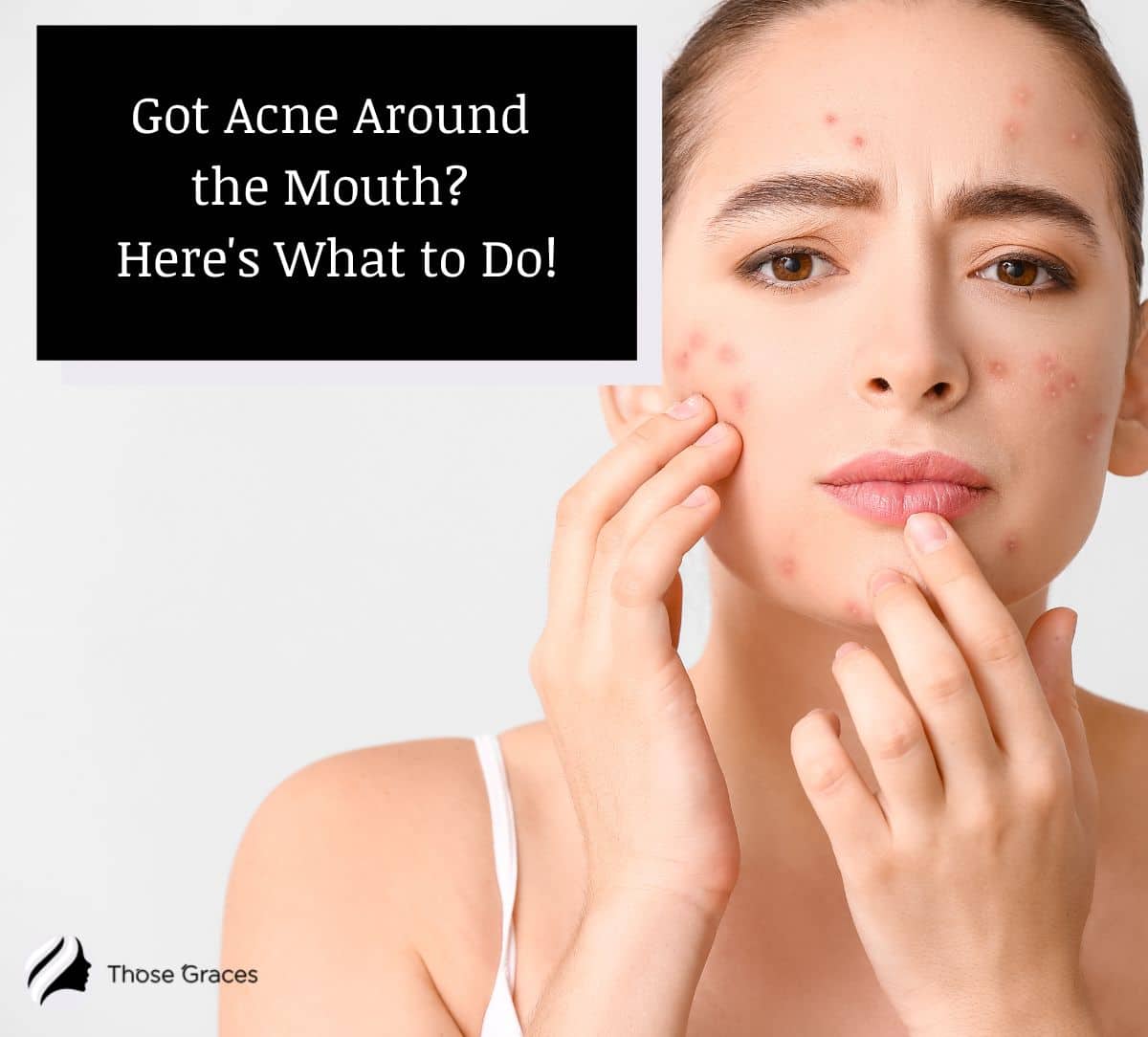Suffering from acne around the mouth?
You’re not alone: Acne around the mouth area is common.
If you’re confused about why it’s there or just looking for a solution, don’t despair further, as I will break everything down like a FRACTION!
Keep reading to learn more about mouth acne and find a treatment that works for you!
Table of Contents
Key Takeaways
- Hormonal changes can play a significant role in causing acne around the mouth.
- This area of the face is often linked to hormonal imbalances, particularly in women during puberty, menstrual cycles, pregnancy, and menopause.
- Diet can also contribute to the development of acne around the mouth. Consuming high glycemic index foods and dairy products may trigger breakouts in this area.
- Neglecting proper skincare can result in acne around the mouth. This can be caused by using harsh products, not cleansing the skin effectively, or leaving makeup overnight.
- Stress can cause acne around the mouth by disrupting hormone levels and causing breakouts.

♥ Uncovering the Mystery of Acne Around the Mouth
If you’re suffering from acne around the mouth, I’ve got you covered:
ACNE is a frustrating and all-too-common skin condition affecting millions of people yearly.
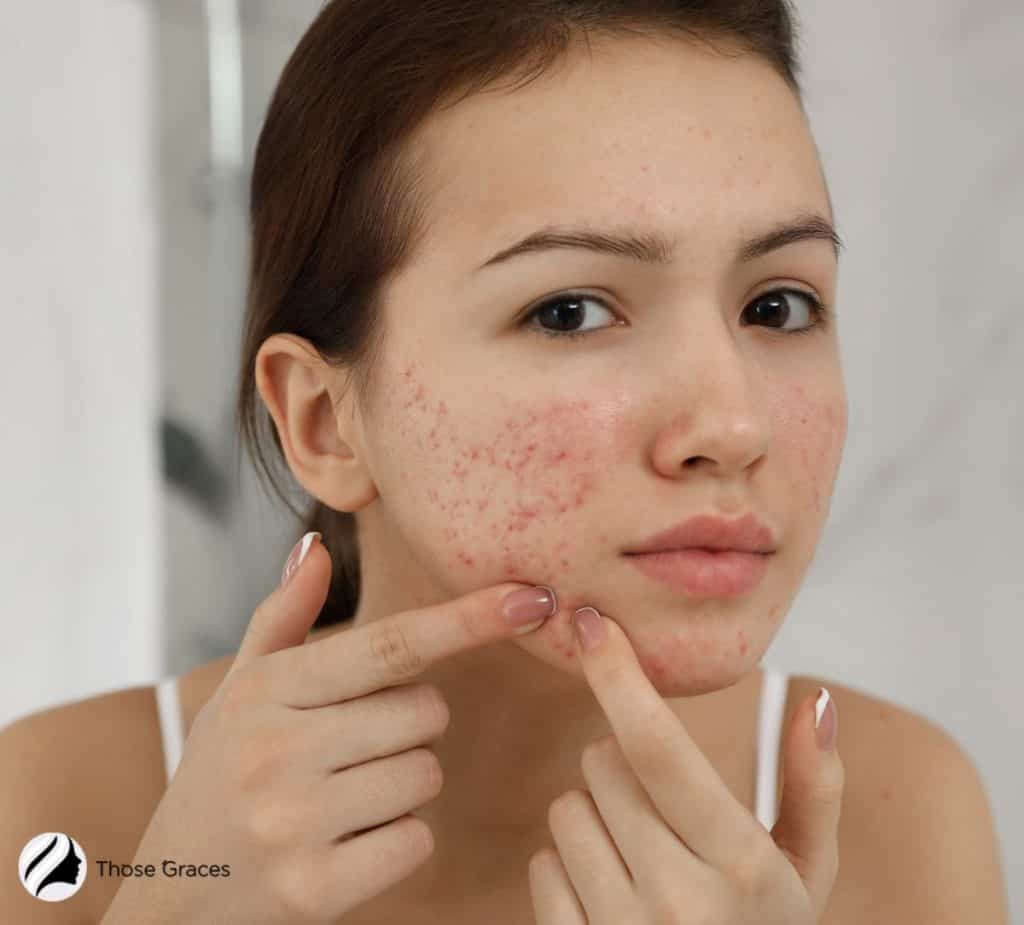
While we often associate acne with teenagers, it’s also a common problem for adults, especially around the mouth, jawline, and chin.
But why does acne develop in this area, and what can you do about it? Let me uncover the mystery of acne around the mouth!
Definition and Overview
Acne is an inflammatory skin condition when dead skin cells, oil, and bacteria clog your pores.
This can result in pimples, blackheads, whiteheads, and even painful cysts.
While the causes of acne are complex and can vary from person to person, some common triggers can contribute to breakouts.
Why Accurate Diagnosis Matters
Diagnosing the cause of your acne is essential if you want to find an effective solution. Different types of acne may require different treatments, so it’s crucial to figure out what’s behind your breakouts.
For example, acne around the mouth could be caused by hormonal imbalances, a diet lacking in fiber, poor skincare practices, or even certain cosmetic products.
Once you know the cause, you can work to eliminate the trigger and reduce the frequency and severity of your acne breakouts.
So, what are some of the causes of acne around the mouth? Let’s take a closer look:
- Hormonal Causes: Hormonal changes and imbalances are common acne triggers, especially in the mouth area.
- Diet-Related Causes: A high-fiber diet has been linked to a reduction in acne, as it may impact androgen levels in the body.
- Poor Skincare Practices: Neglecting to cleanse your skin properly and removing all traces of makeup can clog your pores and lead to acne breakouts.
- Comedogenic Cosmetics: Certain cosmetic products, such as heavy coverage foundation or lip balms, can clog your pores and contribute to acne.
So, there you have it! By understanding the underlying causes of acne around the mouth, you can take steps to reduce the frequency and severity of your breakouts and achieve clearer healthier skin.
If you have oily and acne-prone skin, you might want to check out our articles on the “best Korean face wash for oily acne-prone skin“, “best Korean moisturizer for acne-prone skin” and “best Korean blackhead remover“. These articles provide great recommendations and tips for achieving clearer and healthier-looking skin.
♥ Adult Acne Around The Mouth – Is It Normal?!
Acne is an inflammatory skin condition [1].
It can have a long-lasting impact – not just physically in the form of scarring (we’ve previously given some tips on how to get rid of scars), but also psychologically.
Although we associate acne with teenagers, it’s widespread in adults too. Over 40 million people in the US are affected by acne every year. More than half of those with acne are older than 25 [2].
Further, Gary M White, MD from the University of California, writes the following: “People of all ages are affected by acne, ranging from neonatal and infantile acne throughout adult acne vulgaris.” [3].
Adults, in particular, tend to deal with acne near the mouth area. Adult acne is most common around the mouth, jawline, and chin [3].

♥ Why Do I have Acne Around My Mouth?
There’s not just one single cause of acne – various issues cause it.
Face Mapping is commonly used to isolate areas of the face and analyze the causes of acne in that area [4].
If you hiss at the thought of reading more, then watch this lovely video on face mapping:
As you can see, there are a variety of different face maps. Most agree that acne around the sides of the mouth is primarily related to stress and hormone changes/imbalances.
Acne around the chin/under the mouth is believed to result from a build-up of toxins and diet-related issues (particularly a deficiency in fiber).
♥ Hormonal Causes – Period Acne And Constant Hormonal Acne
Mouth area acne is frequently linked to hormonal changes and imbalances.
It’s normal to develop breakouts around your time of the month.
Hormonal acne is common when you’re ovulating when you start or just before you start your period, or two weeks after your period started [5].
One study found 40% of female subjects with acne had menstrual irregularities [6].
Sometimes hormonal acne is always present. Acne is connected to hormonal imbalance conditions like Polycystic Ovary Syndrome and Congenital Adrenal Hyperplasia.
An endocrine disorder is a possible cause, but this is rare. If you’re concerned that you may be suffering from hormone-related acne, please consult your doctor.
Possible treatments for hormonal acne include androgen receptor (or production) blockers [2].
The combined oral contraceptive pill and spironolactone are the most popular treatment. However, they’re only suitable for certain patients. Always seek advice from your doctor.
♥ Diet Related Causes – Not Enough Fibre?
A high-fiber diet potentially impacts the prevalence of acne around their mouth. Adding 13g to breakfast cereal daily leads to a considerable reduction in acne, according to one 1983 study [7].
High-fibre and low-fat diets are possibly linked to a reduction of androgens in the urine and plasma of adults (acne is androgen-dependent) [8].
In addition to hormonal and diet issues, acne around the mouth can be caused by cosmetic products and ineffective facial cleansing.
♥ Ineffective Cleansing or Touching Your Face

Sometimes people get lazy and don’t remove their makeup correctly after a long day.
If you’re noticing acne around the mouth and chin area, be sure you’re properly removing the build-up of makeup and dirt from the lower half of your face every day.
One face wipe is not enough!
Use a cleanser with acne-fighting ingredients like salicylic acid or benzoyl peroxide (or our natural options below).
Benzoyl peroxide is antibacterial, as well as mildly comedolytic and anti-inflammatory. It works well on inflammatory pimples and cysts [9].
Salicylic acid is an anti-inflammatory with keratolytic effects. It helps reduce the appearance of wrinkles, freckles, as well as acne [10].
To ensure a deep clean, consider investing in a facial cleansing brush like the Clarisonic Mia 2.
A toner works well after cleansing to help prevent oil and dirt from seeping into your pores. Finish off with a hydrating moisturizer because benzoyl peroxide and salicylic acid can dry out your skin.
Sometimes when we’re bored at work or school we rest our hands on our chin or cheek area.
Your hands can quickly transfer bacteria to your face, leading to breakouts in that area. Try to avoid touching your face throughout the day consciously.
♥ Using Comedogenic Cosmetic Products
Acne cosmetica (acne associated with using comedogenic makeup) is fairly common. It’s typically found in women aged 20-40 [3].
A lot of comedogenic makeup can clog up your pores and cause breakouts.
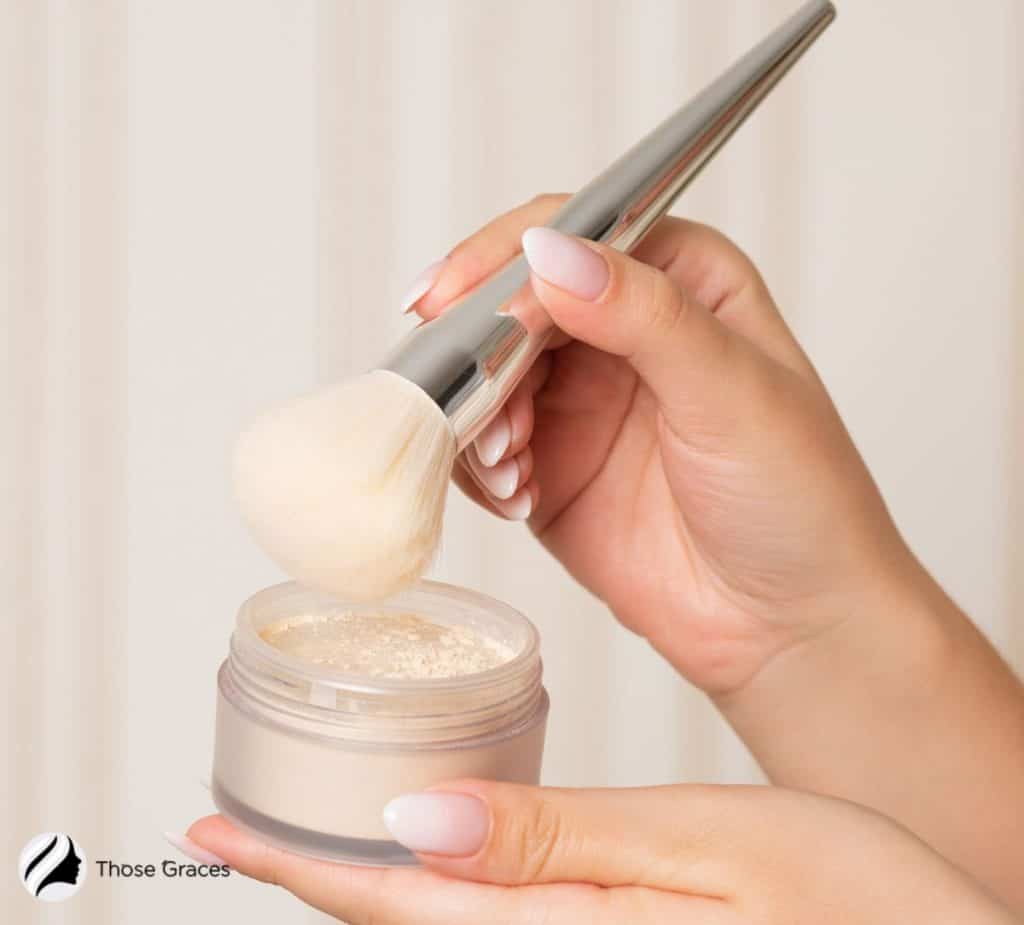
Are you applying heavy coverage concealer and foundation to the area around your mouth to cover up the acne? It can just make the problem worse.
Looking for the perfect Korean essence for acne prone skin? Or maybe you’re in need of a primer that won’t clog your pores? Check out our latest article featuring the best primer for acne prone skin and the best mineral foundations that will give you flawless skin without aggravating your acne.
▼ Does Fluoride Cause Acne?
There’s a possible link between acne around the mouth area and fluoridated toothpaste (particularly the corners of the mouth and chin area) [11][12].
But the research on this is disputed and outdated. There’s a contentious debate over whether or not fluoride is safe [13].
If you’re concerned that your fluoridated toothpaste is the cause of your acne problem, try switching to fluoride-free formula and see if it makes a difference.

♥ How to Treat The Problem
1♥ Switch To Non-Comedogenic Makeup
Don’t worry – you do not need to give up on makeup entirely to help treat your acne! Just try switching to non-comedogenic products.
Non-comedogenic products are formulated without certain ingredients that can clog pores and increase acne risk.
Start using non-comedogenic makeup and use less product around the mouth – you could see a reduction in your acne from that small change alone!
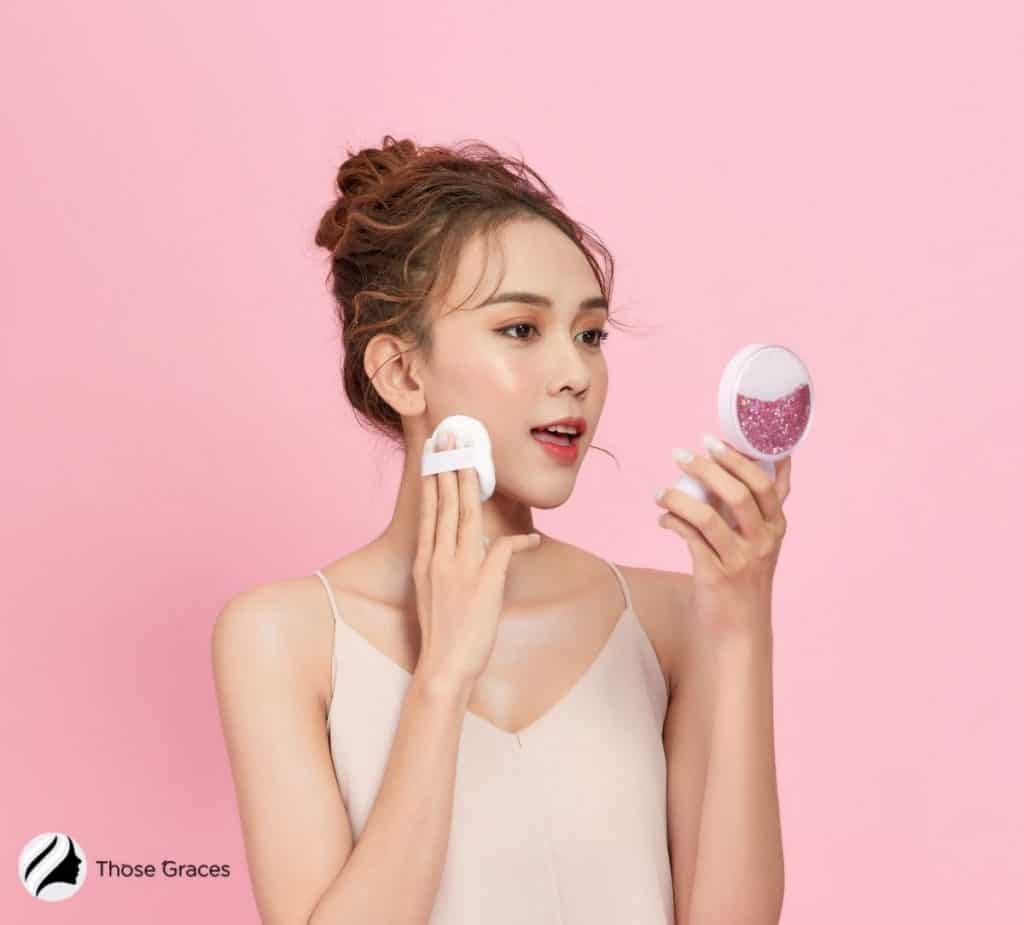
Natural Treatments
Benzoyl peroxide can irritate the skin – stick to concentrations less than 5% to avoid strong irritation. High concentrations of salicylic acid can also cause burning, redness, and stinging [9][10].
Want to avoid potentially harsh chemicals? Check out more natural acne-busting ingredients like green tea and tea tree oil below.
You can also use green tea and tea tree oil to make your own DIY makeup setting spray.
2♥ Green Tea
Green tea is one of the most popular natural treatments for acne. At the time of writing, it has 4.4/5 stars based on 542 reviews on Acne.org [14].
I don’t know about you, but I love drinking a nice, hot cup of green tea in the winter. Green tea is also linked to a possibly faster metabolism and a possible reduction in the risk of certain cancers [15][16]!
Some acne creams and lotions on the market contain green tea. A study found a lotion containing topical (2%) green tea reduced the appearance of mild to moderate acne [17].
Total legions were reduced by 58%, and the mean severity index (SI) fell by 39%.
One research paper found that green tea catechins help inhibit sebum production in men’s foreheads [18].
3♥ Tea Tree Oil
Tea tree oil can help heal the acne around your mouth.
One study found 5% topical tea tree oil helped treat mild to moderate acne. Another compared the efficacy of tea tree oil vs benzoyl peroxide as a treatment for acne [19][20].
Both were effective. While tea tree oil took longer to take effect, it resulted in fewer side effects than benzoyl peroxide.
Many acne-fighting lotions include tea tree oil. Alternatively, you can buy a small bottle of liquid tea tree oil – use a Q-Tip to apply it to your acne.
Apply it on the acne area only. It could irritate the skin if applied all over.
▼ One To Skip?! – Baking Soda
Some people like to use baking soda as an acne treatment.
However, we recommend avoiding baking soda, especially if you have sensitive skin.
While baking soda is great for teeth whitening, it can be too harsh on the skin. It’s a 9 on the PH scale (your skin is at 5) – it’s better to use products at a similar PH level to your skin.
Clearer skin will take some time.
Some academic research suggests wearing makeup can often positively impact the quality of life of those suffering from acne.
Invest in a good blemish concealer to improve the appearance of your day-to-day skin right now.
FAQs
1. What causes acne around the mouth?
2. How can I treat acne around the mouth?
3. Can diet affect acne around the mouth?
4. Is it safe to pop pimples around the mouth?
5. Can stress cause acne around the mouth?
Conclusion
So, now that you know why you get rid of suffering from acne around the mouth, I’m about to wrap all these goodies in a nutshell:
Acne around the mouth can be a frustrating and embarrassing skin condition, but it is also common.
Understanding the causes and potential triggers of this type of acne can help individuals take steps to prevent and treat it.
Hormonal changes, genetics, product irritation, diet, and stress are just a few factors that can contribute to breakouts around the mouth.
Fortunately, there are several things that individuals can do to improve the appearance of their skin.
A good skincare routine, including face washes and topical creams, can help keep the skin clean and clear.
Avoiding irritants and following a healthy diet low in sugar and dairy can also be beneficial.
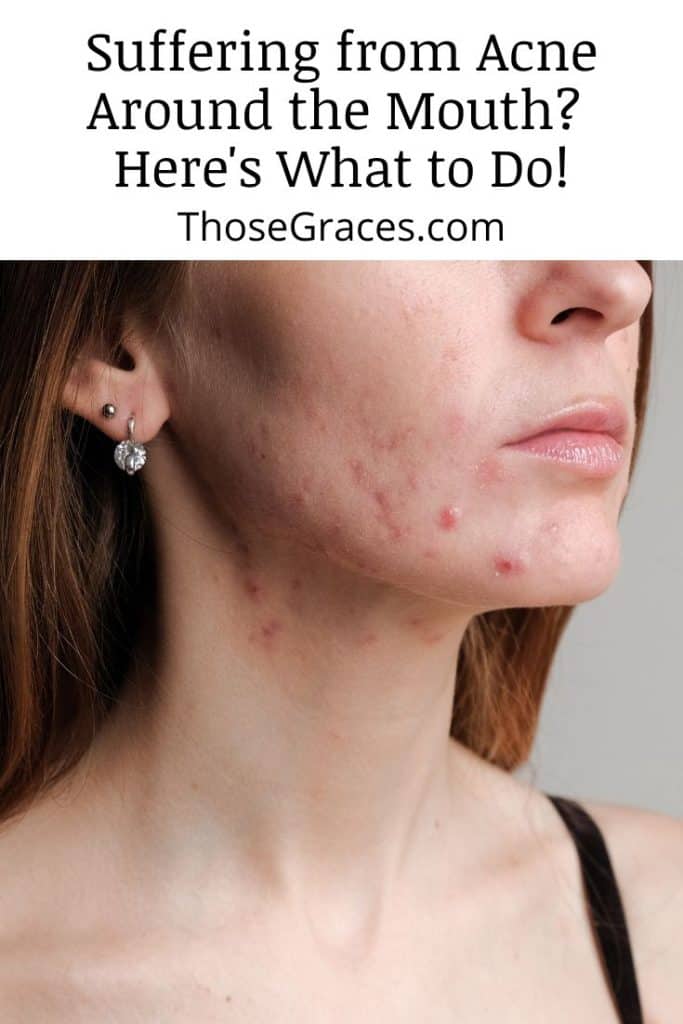
HAVE YOU TRIED OUT ANY OF MY TIPS? LET ME KNOW IN THE COMMENTS!
Resources
1. Antiga E, Verdelli A, Bonciani D, Bonciolini V, Caproni M, Fabbri P. Acne: a new model of immune-mediated chronic inflammatory skin disease. Giornale Italiano Di Dermatologia E Venereologia: Organo Ufficiale, Societa Italiana Di Dermatologia E Sifilografia [Internet]. 2015 [cited 2023 Feb 12];150:247–54. Available from: https://pubmed.ncbi.nlm.nih.gov/25876146/#:~:text=Acne%20is%20a%20chronic%20inflammatory
2. George R, Clarke S, Thiboutot D. Hormonal Therapy for Acne. Seminars in Cutaneous Medicine and Surgery [Internet]. 2008 [cited 2022 Feb 18];27:188–96. Available from: https://scmsjournal.com/wp-content/uploads/2016/01/vol27_i3_Hormonal-Therapy.pdf
3. White GM. Recent findings in the epidemiologic evidence, classification, and subtypes of acne vulgaris. Journal of the American Academy of Dermatology [Internet]. 1998 [cited 2020 Dec 8];39:S34-37. Available from: https://pubmed.ncbi.nlm.nih.gov/9703121/
4. Sharkey L. Face Mapping: Can You Use It to Improve Your Skin’s Health? [Internet]. Healthline. 2019. Available from: https://www.healthline.com/health/face-mapping
5. Hormonal Acne: New Science on How to Beat It | Health to Empower [Internet]. www.paleoforwomen.com. 2019 [cited 2023 Feb 12]. Available from: http://paleoforwomen.com/hormonal-acne-where-its-coming-from-and-what-to-do-about-it/
6. Timpatanapong P, Rojanasakul A. Hormonal Profiles and Prevalence of Polycystic Ovary Syndrome in Women with Acne. The Journal of Dermatology. 1997;24:223–9.
7. Wyrzykowska, et al. N. (PDF) Diet and acne vulgaris [Internet]. ResearchGate. 2013. Available from: https://www.researchgate.net/publication/273722254_Diet_and_acne_vulgaris
8. V�zquez EDP, Sandoval M del RM. Acné, dieta y debate: un veredicto pendiente. Medicina Interna de M�xico [Internet]. 2008 [cited 2023 Feb 12];24:346–52. Available from: http://www.medigraphic.com/cgi-bin/new/resumen.cgi?IDARTICULO=25104
9. Well D. Acne Vulgaris. Journal of the Dermatology Nurses’ Association [Internet]. 2014;6:302–9. Available from: https://journals.lww.com/jdnaonline/Abstract/2014/11000/Acne_Vulgaris__A_Review_of_Causes_and_Treatment.7.aspx
10. DAINICHI T, UEDA S, IMAYAMA S, FURUE M. Excellent Clinical Results with a New Preparation for Chemical Peeling in Acne: 30 Salicylic Acid in Polyethylene Glycol Vehicle. Dermatologic Surgery. 2008;34:891–9.
11. Saunders MA. Fluoride Toothpastes: A Cause of Acne-like Eruptions. Archives of Dermatology. 1975;111:793.
12. Stéciuk A, Dompmartin A, Saussey J, Louvet S, Leroy D. Pustular contact dermatitis from fluorine in an antirust solution. Contact Dermatitis. 1997;36:276–7.
13. Saunders MA. Fluoride Toothpastes as a Cause of Acne-like Eruptions-Reply. Archives of Dermatology [Internet]. 1976 [cited 2023 Feb 12];112:1033. Available from: https://jamanetwork.com/journals/jamadermatology/article-abstract/536085
14. Green Tea [Internet]. Acne.org. [cited 2023 Feb 12]. Available from: https://www.acne.org/green-tea-reviews-207/
15. Hursel R, Viechtbauer W, Westerterp-Plantenga MS. The effects of green tea on weight loss and weight maintenance: a meta-analysis. International Journal of Obesity. 2009;33:956–61.
16. Fujiki H, Watanabe T, Sueoka E, Rawangkan A, Suganuma M. Cancer Prevention with Green Tea and Its Principal Constituent, EGCG: from Early Investigations to Current Focus on Human Cancer Stem Cells. Molecules and cells [Internet]. Korean Society for Molecular and Cellular Biology; 2018;41:73–82. Available from: https://www.ncbi.nlm.nih.gov/pmc/articles/PMC5824026/
17. Elsaie ML, Abdelhamid MF, Elsaaiee LT, Emam HM. The efficacy of topical 2% green tea lotion in mild-to-moderate acne vulgaris. Journal of drugs in dermatology: JDD [Internet]. 2009 [cited 2023 Feb 12];8:358–64. Available from: https://pubmed.ncbi.nlm.nih.gov/19363854/
18. Liao S, Kao Y-H, Hiipakka RA. Green tea: Biochemical and biological basis for health benefits [Internet]. ScienceDirect. Academic Press; 2001 [cited 2023 Feb 12]. p. 1–94. Available from: https://www.sciencedirect.com/science/article/pii/S0083672901620016
19. Morrisett JD, Pownall HJ, Sparrow JT, Jackson RL, Gotto AM. The interaction of apolipoprotein-alanine (apoC-III) with lipids: study of structural features required for binding. Advances in Experimental Medicine and Biology [Internet]. 1975 [cited 2023 Feb 12];63:1–35. Available from: https://www.ncbi.nlm.nih.gov/pubmed/173144%2042
20. Bassett IB, Barnetson RSC, Pannowitz DL. A comparative study of tea‐tree oil versus benzoylperoxide in the treatment of acne. Medical Journal of Australia. 1990;153:455–8.
